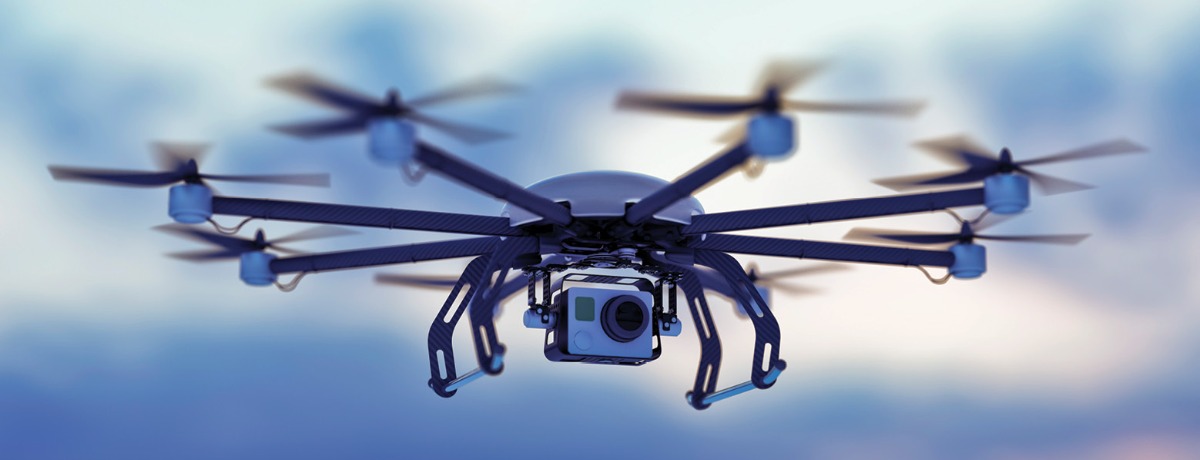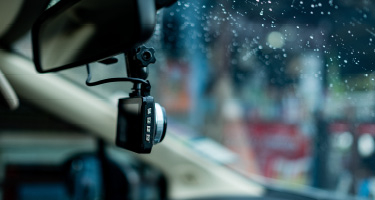You might have seen a drone smacking a car’s windshield in a recent Farmer’s Insurance commercial. Perhaps you saw a drone, as one of the authors did, hovering over a winery in the Midwest countryside. Or maybe you attended an outdoor wedding recorded by a camera drone flying overhead (a real case, discussed below). All these examples illustrate drones’ increasing prevalence—a trend that brings with it risks to insurers, the insured, and the public at large.
As is often the case with emerging risks, government regulation is struggling to keep up: The Federal Aviation Administration changed its drone regulations in 2016 and has already issued two more sets of proposals that, broadly speaking, attempt to maximize drones’ utility while minimizing their risks. Insurers are likewise expanding the use of drones in their everyday business (to inspect disaster damage, for example), but at the same time considering excluding drones from some policies while adding coverage in others. Cases involving drone-related uses and liabilities, meanwhile, are working their way through the courts. We discuss these developments below, with a focus on aerial (as opposed to aquatic) drones.
Increasing Drone Use
Aerial drones, also called unmanned aerial vehicles (UAVs), are a component of “unmanned aircraft systems,” which also encompass ground control, data linkage, and related equipment. Drones have military, commercial, and recreational applications; they’ve also spawned new industries, as we’ll get to.
The U.S. military was the earliest user of drones and related technologies, and drone tech has been deployed by the armed forces of numerous countries—consider the incident a few months ago when the U.S. Navy used electronic jamming equipment to take down an Iranian drone it viewed as a threat to a ship stationed in the Strait of Hormuz near the Persian Gulf.
Disaster investigation and recovery are among the most common uses of drones, which explains why the insurance industry plays such an important part in expanding their commercial role: Insurers were responsible for 17 percent of commercial drone use in 2018. A drone can safely and efficiently assess damage when disaster conditions make it difficult for field adjusters to reach a site.
For this reason, in early 2019, the FAA gave State Farm nationwide permission to fly drones during natural disasters, even beyond the operator’s line of sight or in populated areas, which the agency had not previously permitted. Insurers used UAVs during the 2018 Camp and Woolsey wildfires in California, as well as after a series of deadly tornadoes in Alabama in 2019. In Europe, drones helped first responders target their efforts to save Notre-Dame cathedral in Paris during the April fire there. As fires burn in the Amazon, drones take photos. They fly over disaster areas to assist journalists’ reporting and help responders locate those trapped by lava or landslide. They can deliver medical supplies to areas otherwise accessible only by canoe.
Drones’ nonmilitary uses go well beyond disaster response and include a variety of commercial and even artistic applications. Construction companies use UAVs to survey job sites and determine whether a building surface is level. Real estate firms employ them to photograph every angle of a completed project for advertisements. Insurers use them to manage property risks: UAVs can image and create a 3D map of an insured property, offering insight into the vulnerabilities of low-lying areas. One equipped with an infrared camera can see wet spots on a roof that might lead to damage.
UAVs performed reconnaissance for one hedge fund allowing them to see excess inventory caused by a railway strike, enabling the fund to successfully short the sector. Drone enthusiasts can play ThunderDrone, in which participants fly real drones in simulated combat. Drones recently spray-painted a mural in Turin, Italy.
In addition, drones have spawned entire industries. Building software for drones and defending from aerial incursions have each become a niche business. Companies sell UAV detection equipment that can prevent drones from entering sensitive or private areas. A company under the auspices of Alphabet (the Google parent) recently released an app to help manage UAV traffic in Australia.
The drone detection and management industry was estimated to be worth $1 billion in 2017. In the U.S., Las Vegas police subcontracted with a drone defense company, Dedrone, to assist with security during the final 2016 presidential debate. Dedrone also provided security for the annual global conference in Davos, Switzerland, and has a contract with Fort McNair in Washington, D.C.
FAA Drone Regulations
Regulators are trying to keep up with it all. In 2016, the FAA issued rules concerning recreational and commercial UAVs. Less than three years later, the agency released proposals that would significantly change the regulatory landscape. In general, these new proposals are designed to subject all commercial and recreational uses to a single regulatory scheme, and to expand the permitted uses of UAVs. Such expansion will in turn depend on the development of “remote ID” technology enabling the FAA to identify and track drones as they fly, much like it does now with airplanes.
The 2016 regulations (14 C.F.R. § 107.11-51) apply to “small unmanned aircrafts”—those weighing less than 55 pounds including cargo—but exempt drones operated by hobbyists. These non-hobbyist drones are heavily regulated. They must:
- fly at or below 400 feet, and at or below 100 miles per hour;
- fly within the operator’s line of sight and only during the day;
- fly only in areas that are away from:
- other aircraft;
- non-participating individuals;
- stadiums and sporting events;
- emergency response efforts.
Drone operators may apply for waivers on some of these restrictions.
The restrictions, though, may change for all operators based on regulatory actions the FAA initiated in early 2019. The agency proposed to allow commercial and recreational UAVs to fly at night and over non-participating individuals, albeit with some restrictions remaining. Separately, the FAA has requested comment from the public to help inform future regulations regarding public safety and national security concerns related to UAVs. These future rules might include restrictions on the types of cargo drones may carry, or limitations on their speed and altitude.
These two proposals would bring hobbyist and commercial drones under the same regulatory umbrella, clearing the way for expanded use of commercial drones by reducing the likelihood of hobbyist interference.
The FAA has not yet issued final rules for night use or operations over people, nor issued proposed rulemaking stemming from its request for public input. No regulations increasing flexibility for drone users will be finalized until remote ID technology is developed. Although Congress directed the FAA to promulgate remote ID regulations by July 2018, it has not yet done so. UAV operators will therefore continue to work under the 2016 rules for the foreseeable future.
State and local governments have a role here as well, albeit one limited by federal preemption. In Singer v. Newton, a federal district court struck down sections of a local ordinance in Newton, Massachusetts, about drones because it conflicted with federal regulations. Specifically, the ordinance required that hobbyists register their drones with the city and prohibited operation out of the operator’s line of sight without express permission or a permit from the city. The rule’s stated objective was to protect the privacy of city residents. The court’s opinion highlighted that “a wholesale ban on drone use” would conflict with federal law and be preempted, but also noted that the FAA has said that state and other privacy laws may provide protection for individuals whose privacy has been affected by others’ use of a UAV. Although the FAA will remain the primary regulatory authority for drone operators, we expect further disputes in this area stemming from the interplay between federal regulation and state and local laws.
UAV Risks Create an Insurance Need
Drones present real risks. The risk of property damage, for example: In September 2017, a U.S. Army security helicopter was accidentally damaged by a UAV during the United Nations General Assembly meeting in New York. There’s a risk of bodily harm as well: In 2016, a wedding guest was allegedly injured when the photographer’s drone hit her, costing her the sight in one eye. She filed a negligence suit against the photography studio, which led to related insurance litigation discussed below.
Drones also present a significant risk of business-interruption loss even in the absence of property damage. Three major airports experienced multiple shutdowns in late 2018 and early 2019 when UAVs flew into restricted airspace. Gatwick and Heathrow airports in the United Kingdom, and Newark Liberty International in New Jersey, grounded flights and stranded hundreds of thousands of people out of concern that the drones would attack planes.
To sum up, drone-related risks include:
- first-party loss, including harm to the UAV or harm to the UAV operator’s own property, and resulting interruption of the company’s business;
- third-party liability, including bodily injury, property damage, liability for invasion of privacy, and third-party business interruption; and
- malicious attacks through hijacking and cyber-hacking, which can result in both first-party losses and third-party liabilities.
Although the FAA does not require drone owners and operators to carry insurance, it has highlighted the potential liability drone operators face and has encouraged them to secure appropriate coverage. We focus next on insurance coverage for risks to commercial drone owners and operators, and to third parties.
Insurers have begun to address drone-related risks specifically in certain policies. Some expressly exclude drone-related losses and liabilities, while others specifically cover such risks, whether as stand-alone specialty policies or through endorsements of other policies.
Commercial General Liability policies (CGLs) typically contain aviation exclusions, which at least one court has applied to drones. In Philadelphia Indemnity Insurance Co. v. Hollycal Production, the case in which a drone allegedly hit a wedding guest, a federal court granted summary judgment for the insurer (the motion was unopposed) based on the plain language of the policy’s aircraft exclusion. Around 2015, standard CGL policies began to incorporate specific drone or “unmanned aircraft” exclusions. However, some Business Owner policies (which combine both first-party property and general liability coverage) also offer endorsements designed to provide coverage for drone-related losses, including first-party loss due to theft and third-party liability.
Most cyber-insurers have not yet specifically addressed drones or aircraft-related losses and liabilities. To the extent that the cyber-hacking of a drone caused physical damage, many cyber-insurers could point to exclusions in their standard cyber policies. For example, a recent cyber form from the insurer AIG contains an exclusion for “Loss . . . arising out of, based upon, or attributable to any Bodily Injury or Property Damage.” On the other hand, most cyber policies should respond to cybersecurity breaches that expose or damage data collected or transmitted via the unmanned aircraft system. If hackers breached the communication system connecting the operator and the drone, they could capture proprietary information gathered by the latter—but some cyber policies specifically exclude the unauthorized collection of information under certain circumstances. For instance, a form from insurer Chubb excludes coverage for “the unauthorized or surreptitious collection of Personal Information by the Insured or the failure to provide adequate notice that such information is being collected.”
Major media insurers’ forms generally provide coverage for claims arising out of the “gathering” of material by the policyholder or on its behalf, without limitation as to how such material is gathered. That means the policyholder may be protected under its media policy for claims alleging that drone use resulted in a violation of privacy, including wrongful entry or trespass by “manned or unmanned aircraft.” Policyholders using drones to collect information should be sure their media policies cover information gathering regardless of how it’s collected.
Aviation insurance is also available to cover both first-party losses and third-party liabilities from UAVs, either as part of a general aviation policy or as a free-standing UAV-specific policy. Drone-specific insurance typically covers both first- and third-party risks. Once such policy is offered by a company called Verifly, which provides on-demand commercial and recreational UAV insurance based on the location and duration of the drone operation, sometimes for as short as a one-hour flight. Others offer coverage for first-party losses due to equipment failure, damage to the drone, and injury to the drone operator. AIG also provides the option to add cyber and other coverage for commercial drone use. Many other insurers, from droneinsurance.com to AGCS, offer UAV-specific coverage.
Conclusion
Companies using drones for commercial purposes confront rapidly evolving technology and business opportunities, changing regulations, increased exposure to liability and first-party loss, and an insurance market that is adapting to all these emerging and evolving risks. Even companies that do not themselves use drones can face UAV-related risk exposure. As with other emerging risks, some insurers are in the process of attempting to exclude drone-related risks from standard forms in property, general liability, and other traditional insurance lines while offering new specialty products or specific endorsements covering those risks (for an additional premium). These newly minted exclusions and coverage grants can vary widely. They warrant close review and expert attention.
--------------
Marialuisa Gallozzi is a partner at Covington & Burling LLP in Washington, D.C. She serves as lead counsel in representing for-profit and nonprofit policyholders in recovering for first-party losses and third-party liabilities. Her recognitions include Chambers USA and Washington D.C. Super Lawyers "Top 100 Lawyers." She is a fellow of the American College of Coverage Counsel.
Laura Beth Cohen is a litigation associate with a focus on insurance recovery at Covington & Burling LLP in Washington, D.C. She represents policyholders in first- and third-party disputes and advises on risk management issues. Ms. Cohen contributed research to the American Law Institute's forthcoming Restatement of the Law of Liability Insurance.
photo: ISTOCK.COM/MAILFOR
































